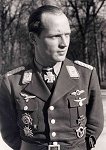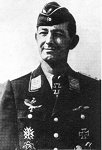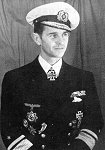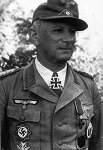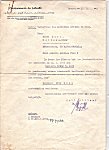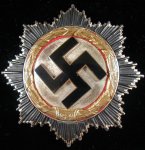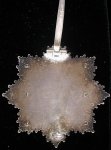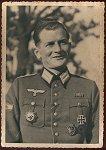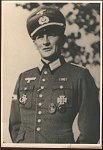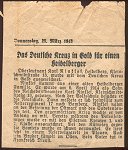
By François Saez and Jacques
Calero
Conditions for Bestowal
| Click on images to enlarge | |
 Preparation of a Luftwaffe award ceremony.
|
|
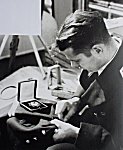
|
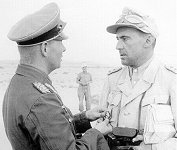 |
| New recipient of KM sewing loops to put his DKiG on is tunic | Fritz BAYERLEIN, Oberst i.G. receiving the DKiG (23.10.1942) from Rommel |
The decoration could only be awarded exclusively by the Commander in Chief of the Wehrmacht, or the Commanders in Chief of the Army, Navy, and Air Force, though later also by Army Group Commanders, and in the case of a member of the General Staff, by the Commander in Chief of the Army.
The recipient of the German Cross in Gold had to already be a holder of the Iron Cross 1st Class 1939 or of the 1939
Clasp (Spange) to the 1914 Iron Cross 1st Class. It required at least the War Merit Cross 1st Class with Swords to receive the German Cross in Silver.
For naval personnel, bestowal of the German Cross followed a calculated system of points in terms of the number and type of engagements.
In 1944, bestowal of the Close Combat Clasp in Gold automatically included bestowal of the German Cross in Gold (HM 1944 S.283, 21/9/44)
| Click on images to enlarge | ||
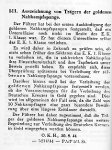
|

|

|
|
Copy of the text (HM 1944 S.283, 21/9/44) In 1944, bestowal of the Close Combat Clasp in Gold automatically included bestowal of the German Cross in Gold |
Major Helmuth WANDMAKER II/PZ.GR.RGT.76 RK 5/04/45 DK 1/06/44 NAHKiG 7/04/45 |
SS-Hauptscharfuhrer
Gustav SCHREIBER 7./SS Pz Gr Rgt 9 ''Wiking'' DK 14/1/43 NiG 7/12/43 RK 2/12/43 |
It was possible to be awarded the Cross in both Gold and Silver. In principle, only the Cross in Gold could then be worn. Nevertheless, a contemporary photo shows both awards being worn at the same time by the then Kapitän zS zV (later Konteramiral zS zV) Dr. Paul MEIXNER .
Then Oberst iG zV (later Generalleutnant zV) Bodo ZIMMERMANN on the Staff of OB West also received both Crosses (DKiS 15.2.43 Oberst iG zV Ia OB West AND DKiG 25.9.44 Oberst iG zV Stab OB West).
The Cross in Gold was worn above the Cross in Silver.
| Click on images to enlarge | |

|
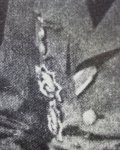
|
|
Kapitän zS zV (later Konteramiral zS zV) Dr. Paul MEIXNER |
|
The German Cross could also be awarded posthumously, in which case the decoration and award certificate (Besitzzurkunde) were sent to the next of kin.
In the case of loss or damage in combat, free replacement of the decoration could be requested from the Orders Chancery (Ordenkanzlei ). The same procedure could be used to obtain a wearing copy (zweites stück ), but this was made difficult.
|
Document send to General SPANG at the hospital notifying him of his DKiG award. |
Letter to Bach's wife awarding Lt.Otto Bach (JG1) the DKiG - posthumously. |
It should be noted that the German soldiers themselves referred to the DK as "Hitler's fried Egg", a practice which continues even amongst surviving veterans today.
The German Cross With Diamonds
In the month of October 1942, Hitler authorized the manufacture of German Crosses in Gold With Diamonds. Twenty examples were made by the jeweler RATH in Munich. These Crosses were sent to the Orders Chancery (Ordenkanzlei der Präsidialkanzlei des Führers) and kept by Dr. Doehle (Unterstaatssekretär). They were never awarded. At the end of the war, these all ended up in Austria at Schloss Klessheim, where the ‘’Diamond’’ Crosses were confiscated by an American army officer. Three of these Crosses are now found in the museum of the United States Military Academy at West Point, the others are in private collections.
Recipients
The known number of recipients of the German Cross was divided in the following categories:
| Cross in Gold: | Cross in Silver: | |
| Army | 14,637 | 867 |
| Navy: | 1,481 | 105 |
| Air Force: | 7,248 | 65 |
| Waffen SS | 822 | 70 |
| HJ-Leaders : | 1 | |
| Volksturm : | 1 | |
| General SS : | 1 | |
| Police : | 1 | |
| TrKpsSpeer : | 1 | |
| RKomSeefahrt : | 1 | |
| Org. Todt : | 3 | |
| Foreigners: | 14 | 0 |
| Total: | 24,204 | 1,115 |
These figures are only approximate, because in the last weeks of the war the Crosses were certainly awarded, but not listed, or the archives have disappeared in any event.
Two of the Gold and seven of the Silver usually counted in ‘’ Army’’ lists were actually for other forces, as shown above.
No doubt there were unlisted awards to other odd organizations which were not published.
It is also to be noted that these decorations were never awarded to female personnel.
According to the new book "Das Deutsches Kreuz 1941 - 1945" , Band II written by K.Patzwall & V.Scherzer there are a total off 26987 awards (both German Cross gold and Silver).
Knight of the Reich - Karl Rinklef
- Iron Cross 2nd Class – 24.10.39 as a First Lieutenant with Aufklärungsabteilung 27, (27th Reconnaissance Battalion , 27th Infantry Division).
- Iron Cross 1st Class – 27.6.1941 der Panzerraufkärungsabteilung 27 (27th Panzer Reconnaissance Battalion, 17th Panzer Division)
- German Cross in Gold – 11.3.1943 with Kradschutzenbatallion 17th (17th Motorcycle Battalion, 17th Panzer Division)
- Single Tank Destruction Strip (2)
- Panzer Assault Badge
- Close Combat Clasp
- Wound Badge in Silver
- Wound Badge in Black
- Eastern Campaign Medal
- 4 year Service Award
- Entry into Austria Award
Oberleutnant [First Lieutenant] Karl Rinklef was born April 6th, 1914, in Heidelberg. At the onset of the war he was with the 27th Infantry Division, a unit which distinguished itself for its gallantry in the victorious Polish and French campaigns where Oberleutnant Rinklef earned the Iron Cross Second class during the opening campaign of the war.
In the fall of 1940 the 27th Infantry Division was converted to the 17th Panzer Division and in June of 1941 it blitzed into Russia with Army Group Center fighting with Guderian's 2nd Panzer Group at Minsk and Smolensk. It later participated in the battle of Moscow. Amongst the unit's accomplishments are the destruction of 100 tanks in a single day (June 9, 1941, at Orsha). Three days before that, Karl Rinklef had earned the Iron Cross 1st Class.
The 17th stayed with Army Group Center until it was dispatched to relieve the encircled 6th Army at Stalingrad, however they were themselves encircled and had to fight their way out. By the time Christmas came in 1942, the unit was badly shaken and down to only eight tanks and one anti-tank gun. In March 1943, the refurbished division participated in von Manstein's counterblast toward Kharkow and Belgorod; it was there that Oberleutnant Rinklef distinguished himself and earned the German Cross. The unit also fought at Kursk, and then in the retreats from the Donets, the Dnieper bend, and the northern Ukraine. In March 1944 the unit was once again encircled with the 1st Panzer Army but succeeded in breaking out one last time. In September of the fourth year of the war it was fighting west of the Vistula, and it opposed the Russian drives east of the river in the winter of '44-'45. At the end of the war, it was in the pocket east of Prague.
Karl Rinklef survived the war.
Below are two photographs and translation of newspaper articles announcing the award of his the German Cross.
| Thursday, March 25, 1943 The German Cross in Gold for a Man from Heidelberg Oberleutnant [First Lieutenant] Karl Rinklef, of Heidelberg, Kleinschmidtsraße 13, was awarded the German Cross in Gold. Rinklef comes from an Heidelberg family. He was born on April 6, 1914, the son of the Federal Bank employee Karl Rinklef, Kleinschmidtsraße 13. After elementary school (4 grades), he attended the Realshule [secondary school with emphasis on modern languages]. Then he volunteered for military service and joined the Reiterregiment 17 [Calvary Regiment 17] in Bamberg. Rinklef took part in the liberation of the Okmark and the Sudetenland. He participated in the current war from the beginning. Already during the Poland campaign, he was awarded the Iron Cross First and Second Class. During the fighting against the Soviets he was severely wounded. At present he is hospitalized in a reserve military hospital in Plauen. His brother is also fighting in the East, his father is doing duty in France. |
|
|
|
|
| Local=Chronik [Local Chronicle] Heidelberg, March 25, 1943 Oberleutnant Karl Rinklef from Heidelberg was awarded the German Cross in Gold. The valiant soldier from Heidleberg is son of the Reichsbank-Oberzählmeister [upper level accountant at the Reichsbank] Karl Rinklef, Kleinschmidtsraße 13. He was a volunteer in Franconian Calvary regiments and as a soldier he already took part in the liberation of the Ostmark and the Sudetenland. During the Poland Campaign he was awarded the Iron Cross both grades. Severely wounded, he is at present in a field hospital in Saxony. |
|
For questions, comments or additional information on the above group contact Sebastian
Bianchi
![]()
© Copyright Wehrmacht-Awards.com LLC |
